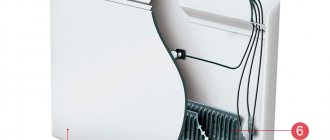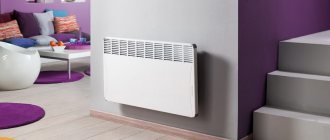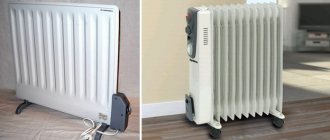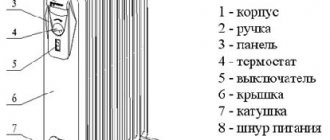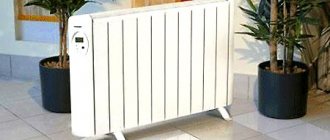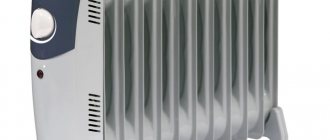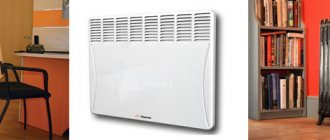Oil type heaters
These devices are very widely used to increase the air temperature in an apartment or house. Installing them is extremely simple; no special skills or knowledge are required. Plug the device into the outlet, placing it closer to the heated area - and you're done. Thanks to the simplest possible design, breakdowns of the device's electrical circuit are unlikely.
Several models of oil radiators - the one on the far left is equipped with a fan.
The design of the oil cooler is based on a metal reservoir with mineral oil poured inside it. The oil, in turn, contains a heating element. As a rule, a device of this type is equipped with a rheostat for temperature control, a compartment for the power cord and electrical protection against overheating. Sometimes the heater also has a sensor that detects deviation from the horizontal. This allows you to automatically turn off a device that has tipped over. Oil radiators are also splash-proof.
Oil radiators are equipped with a handle for easy movement around the apartment.
The heaters are equipped with swivel wheels.
The cord compartment is designed to store the power cable when not in use.
Advantages of the oil device:
- Low price;
- Quiet operation;
- Ease of movement over various distances, for example, from room to room.
To determine how much power the device will need to make the room warm, we will use the following rule. If the ceiling height does not exceed three meters, then to heat 10 square meters of space you need a radiator with a capacity of 1 kilowatt. Basically, similar devices are produced with a power range from 1 to 2.5 kilowatts.
The device usually has a thermostat that automatically sets the desired temperature, maintaining it at the same level. Models equipped with a timer are very convenient - it will turn on the heater at the appointed hour. For example, you can schedule heating for the morning or evening, when all household members arrive from work. Thus, the timer allows you to save a fair amount of electricity, which is very expensive today.
Heater with electronic control system.
Mechanical control system.
Conclusion
It is worth choosing between a convector and a radiator based on the specified technical characteristics of the room and the heating system as a whole, as well as taking into account individual design and interior preferences, and you should also pay attention to the price of the solution.
For qualified assistance in selecting radiators or heating convectors, we suggest contacting experienced specialists. We have been working for more than 10 years: we will help you choose the heating device that is right for you!
What heating devices are in your house or apartment? If you haven’t decided yet, which one are you leaning towards and why? Share your story and ideas in the comments!
Convector heaters
They differ from oil radiators in the shape of the body - they are flat and smooth. It has a room thermostat, thanks to which the room maintains the desired temperature.
Simple convector heaters in a classic design.
Unlike oil-type heaters, which are mainly floor-mounted, convector radiators are mainly mounted on walls. But there are also floor-standing models - they usually have wheels for movement.
A convector that has fastenings and can be either hung on a wall or installed on wheels.
Skirting convectors can be from 15 cm in height and 1500 cm in length.
Oil-type heaters radiate heat. Convectors have minimal heat radiation - only from the front panel. And the heating of the air occurs due to the exchange of heat between cold and hot air masses. In this case, there is a constant movement of air along the surfaces of the heater.
Convectors do not make any noise; their operation is based on a natural process - air convection. They heat the room quickly and evenly. Mounting the device on the wall is easy and simple, and if desired, you can install it on the floor. There are convector heaters for both home and office, commercial or industrial premises.
In a convector device, air moves, moving to different heights. Hot, more rarefied air flies upward, towards the ceiling, and heavy, cold air tends downwards, towards the floor. If convection occurs correctly, then flows of air masses constantly arise, heating the room.
This is how air masses move through the process of convection.
The device consists of the following elements:
- Convection chamber (heater body);
- Heating element built into the housing.
Convector heater with front cover removed.
During operation, cold air entering the convector is heated by a heating element. The air becomes lighter, it rises and exits through the upper blinds. Well, a new portion comes to replace the cold air in the room that has gone up.
The heated air has a temperature set on the thermostat. It turns the heating element off and on. The operating efficiency of this device is very high. The slots located on the front panel are designed to allow hot air to escape. So that it does not move straight up, but heats the floor and walls, the blinds for its exit are directed downwards. The air does not come out immediately, but accumulates inside and receives excess pressure. After this, it exits the device in a horizontal direction.
Convector heater thermostat.
Since the heating element is specially fixed in the housing, you don’t have to worry about grounding. After all, the heating element does not have contact with the metal of the body - between them there are stops made of special heat-resistant plastic. And the design of the device is made in such a way that the heat in the room is distributed evenly. This achieves coziness and comfort.
For those who cannot decide whether to buy a convector or oil heater, it would be useful to know about the advantages of convector heaters:
- These devices are fireproof and meet the requirements of European standards.
- Such heaters placed in each room and combined into one network can create a modular heating system. At the dacha or in a country cottage, it can be used instead of a boiler, which is expensive and requires the installation of numerous heating pipes,
- Thanks to the electronic thermostat and various operating modes, you can save a lot of electricity.
Electronic control system and on/off timer.
Which is better - a radiator or a convector?
The use of modern convectors for centralized heating meets basic consumer requirements. This is a modern type of heater that has many advantages. Convectors can be built into any partition or floor so that they are not visible. Such devices can easily replace conventional radiators, which do not always fit harmoniously into the interior.
Underfloor heating convector is a modern solution for home and apartment
However, in urban apartments with a standard layout, some models of convectors are simply impossible to use. For example, it will not be possible to install such a device inside the floor.
Otherwise, such models are a good solution for organizing home heating; you just need to give preference to high-quality devices and correctly calculate their power and quantity.
Convector and oil heater - comparison reveals the undisputed leader
So, let's compare the main indicators of the two most popular heaters.
1. Economical use. An oil radiator consumes a quarter more electricity than a convector radiator. Since electricity tariffs are constantly rising, this fact may be decisive when choosing a device.
2. Warm-up time. Heating the air with an oil heater goes through several stages: first, electricity heats the heating element, then the heating element heats the oil, and it, in turn, heats the fins of the housing, which gives off heat to the air masses. This takes a lot of time (and costs a lot of electricity) - the device has been turned on for a long time, and the cold is still in the room. Fans built into the oil heater can speed up the process.
Oil-type heater with built-in electric fan.
In a convector, the heating element immediately heats the body, so its efficiency is at least 95 percent. But the heating rate is also not so high and an oil radiator equipped with a fan, all other things being equal, is more likely to outperform a convector.
3. Comfort during work. This refers to ease of carrying and installation. It should be noted that convectors are more convenient and mobile in this regard. Their weight is no more than 10 kilograms, and oil devices are more bulky and heavy - their weight ranges from 18 to 25 kilograms. Convectors on wheels are more convenient to move, and they are easy to mount on the wall, which will save space in the apartment and make cleaning easier. In addition, the temperature created by the convector is more comfortable. It has no differences throughout the entire volume of the room.
4. Security. You understand that hot oil is not the best neighbor. It heats up the heater body so much that it’s not far from a burn. The exception is heaters equipped with a protective casing.
A radiator with a protective casing to protect against burns that can be caused by touching a hot radiator body.
But convector devices can be called absolutely safe. After all, their body heats up to only 60 degrees, and at this temperature you cannot get burned. Equipped with a protection function, a convector left unattended will not cause any harm to the owner. But under no circumstances should an oil device be left alone with the room - after all, some of its models do not even have an overheating sensor.
5. Service life. Probably more than one person has witnessed oil leaking from an oil heater. Sooner or later a leak appears. First, a microcrack appears on the body, then oil begins to slowly evaporate through it. Well, in the end the heater fails, and no one undertakes to repair it - is it possible to find a tiny microcrack. As for convector heaters, they last for 10 and 15 years, although the manufacturer usually specifies a warranty period of 5 years.
6. Environmental friendliness of the device. To begin with, let’s take it as an axiom that dust in a room will always rise when air moves during convection. That’s why sellers lie when they talk about some special models of convection or oil heaters that don’t raise dust. Now about the combustion of oxygen. For convectors, the peculiarity of the heating element material and the heating temperature of the housing are such that this process is physically impossible. Some argue that oxygen combustion is still possible with oil radiators. Don't believe it - it's not true.
Not a single heater burns oxygen - there is no open combustion in them!
7. Cost of the device. The cost of convector and oil heaters is approximately the same. But do not forget about the ratio of price and quality, that is, compare not only prices, but also the most important technical indicators (discussed above).
Prices for oil heaters:
Prices for convector heaters:
How to make the right choice
The numerous radiators and convectors currently on the market are varied, so choosing just one device will not be so easy. It must be remembered that each device, regardless of its type, has its own advantages, and in many situations they are able to operate at almost equal power. Keep in mind that any radiator of correctly selected power will warm the room, but a convector is much safer and does not cause any inconvenience - this is the main difference between the devices.
If we are talking about a small room, it is better to choose a radiator; this is the best option for heating a local space.
When it comes to what is better - a convector or a radiator, many mention the extremely low cost of the second option, which also significantly increases the demand for it. Despite this, innovative and modern convectors are becoming more and more popular every year, as manufacturers produce additional modifications of such devices. Now they can be installed in any room, built into the floor (in-floor models), mounted on the wall (wall-mounted) or placed on the floor (floor-mounted) in a convenient and most suitable place. To make the right choice, you need to take into account the features of a particular room, its area, decoration, size and design. You can choose either a radiator or an electric convector of any type.
Comparative table of technical characteristics of oil and covector heaters
| Options | Oil heater | Convector heater |
| Economical | - Low economical. | + Approximately 25% more economical. |
| Heating time | +- Conventional models take a long time to heat up, but those equipped with fans heat up quickly. | — Heats the room for a long time. |
| Comfort to use | - Average. | + Both floor and wall models are more convenient. |
| Safety | — High surface temperature (but there are models with a protective casing); If the operating rules are violated, there is a risk of explosion. | + The surface of the convector is not subjected to strong heating; can be left unattended. |
| Life time | - Average | + Large |
| Environmental friendliness | — Raises dust particles due to convection | — Raises dust particles due to convection |
And based on the totality of all of the above, we can clearly conclude that it is best to purchase a convector. Lightweight, compact, silent and safe, these heating devices are gradually replacing heavy, short-lived devices filled with hot oil from apartments and offices. So we can say that oil heaters have almost become a thing of the past in the matter of heating rooms.
The only thing is that models of oil heaters equipped with fans are able to heat the room somewhat faster, but the process of heating its surface itself remains long. See below for detailed materials on choosing these heaters.
